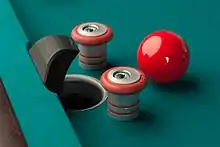Bumper pool
Bumper pool is a pocket billiards game played on an octagonal or rectangular table fitted with an array of fixed cushioned obstacles, called bumpers, within the interior of the table surface.[1][2] The surface of the table has the same cloth covering as a standard pool table. Unlike most types of billiards tables, there are only two pockets.

Table

Typically bumper pool tables are smaller than a regulation pool table.[2][3] The table has two pockets, placed opposite one another, located at the center of two of the rails.[2]
Most tables have twelve bumpers, although some tables have fourteen or sixteen.[2][3] Two bumpers flank each pocket.[2] The remaining bumpers are arranged in a cross in the center of the table, with one line of the cross in line with the pockets.[2] At the center of the cross, there is an open space just large enough to allow a ball to pass through. Tables with fourteen bumpers have three rather than two bumpers on each side of the center space on the line midway between the two holes.[2]
Gameplay
The game is played with 5 red and 5 white balls, with one marked ball in each set.[1][2][4] At the start of play, each set of balls is arranged on five spots near each edge of the table by a pocket with the marked ball placed directly in front of the pocket.[2] The object is for a player to sink all of their balls into their pocket at the opposite end of the table.[2][4] Certain rule sets[2] state that the player's marked ball must be sunk before the player can shoot any other balls, while other rule sets[4] state that the player's marked ball must be sunk before the player can sink any other balls (though they are still allowed to be shot). Unlike most other billiard games, there is no designated cue ball; any ball may be shot directly with the cue stick, including into a pocket, rather than the more common rule that a cue ball must be hit into the intended ball.[1][2]
To begin play, both players shoot their marked ball simultaneously, banking the ball off the cushion to their right and attempting to sink their ball in their pocket at the other end of the table.[1][2] If both players sink their first shot they each select another ball, place it in front of their opponent's pocket, and repeat the simultaneous shot.[1][2] If both players successfully sink all five of their balls in this fashion the game ends in a draw.[1][2]
If, on the initial simultaneous shot, one player fails to sink his or her marked ball in the pocket, the player who successfully sank a ball or who came closest to his or her own pocket shoots next. A player's turn continues until he or she fails to sink a ball.
Fouls
If a player sinks one of the opponent's balls there is no penalty. However, the ball is considered sunk regardless of which pocket it drops in. If a player sinks one of his own balls (but not the last) in their own pocket, the opponent may drop two of their own balls into their pocket.[2] A player sinking their last ball in the wrong pocket loses the game.[2] If a player causes a ball to leave the table, their opponent may place that ball anywhere on the table (usually in the middle space surrounded by bumpers) and may (depending on local custom[2]) drop two of their balls into their pocket. Jump shots are not permitted in bumper pool.[1][2][4]
References
- "Bumper Pool". Billiard World Magazine. Retrieved 25 January 2010.
- "Sinking Bumper Pool Table Balls By the Rules". Bumper Pool Table Facts. Archived from the original on 23 December 2009. Retrieved 25 January 2010.
- "Bumper Pool Table". Bumper Pool Tables vendor site. Bumper Pool Tables. Retrieved 25 January 2010.
- "Bumper Pool Rules". Bumper Pool Tables vendor site. Bumper Pool Tables. Retrieved 25 January 2010.

